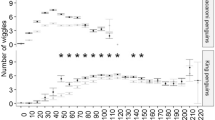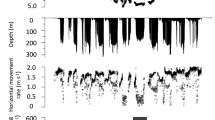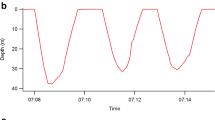Summary
Time-at-depth data, recorded by animal-attached miniature depth gauges, were examined in 8 Gentoo Penguins. Birds showed two depth utiliuation patterns, (1) decreasing time with increasing depth, which we interpret as due to “bounce-diving” in the pelagic zone and (2) constant time per depth interval down to specific depths where large time peaks were encountered. We interprete this as “flat-bottomed” diving in benthic-foraging birds. Multiple maximum depth data reported in the literature for various penguin species were analysed to try and reconstruct proportional time-at-depth. These results, together with real time-at-depth data, indicated that penguin depth utilization was strongly mass dependent with larger species spending a greater proportion of time in deeper water.
Zusammenfassung
Miniatur-Tiefenmeßgeräte wurden 8 Eselpinguinen angeheftet und die gewonnenen Daten der Aufenthaltsdauer in verschiedenen Wassertiefen untersucht. Die Vögel zeigten zwei Muster der Tiefenausnutzung, (1) abnehmende Aufenthaltsdauer mit zunehmender Wassertiefe, das wir als „Stoßtauchen“ im Pelagial interpretieren und (2) konstante Aufenthaltsdauer pro Tiefenintervall bis in bestimmte Tiefen, in denen lange Verweildauer registriert wurden. Letzteres interpretieren wir als „Grundtauchen“ bei Vögeln, die am Meeresboden nach Nahrung suchen. Aus der Literatur wurden „multiple Tiefenmaxima“ für verschiedene Pinguinarten entnommen und analysiert, um die Aufenthaltsdauer pro Tiefenintervall zu rekonstruieren. Diese Ergebnisse zeigen zusammen mit tatsächlichen Meßdaten, daß die Tiefenausnutzung der Pinguine stark massenabhängig ist, wobei größere Arten eine größeren Zeitanteil in tieferem Wasser verbringen.
Similar content being viewed by others
Literature
Adams, N. J. (1987): Foraging range of King Penguinsaptenodytes patagonicus during summer at Marion Island. J. Zool. (London) 212: 475–482.
Ditto &M.-P. Wilson (1987): Foraging parameters of Gentoo Penguins (Pygoscelis papua) at Marion Island. Polar Biol. 7: 51–56.
Brown, C. J. (1987): Traveling speed and foraging range of macaroni and rockhopper penguins at Marion Island. J. Orn. 58: 118–125.
Burger, A. E., &R. P. Wilson (1988): Maximum depth gauges for marine animals: an assessment of their accuracy and deployment. J. Orn. 59: 345–354.
Butler, P. J., &D. R. Jones (1982): The comparative physiology of diving in vertebrates. Advances Comp. Biochem. Physiol. 8: 179–364.
Cooper, J. (1986): Diving patterns of cormorants (Phalacrocoracidae). Ibis 128: 562–569.
Croxall, J. P., &P. A. Prince (1980): The food of Gentoo Penguin (Pygoscelis papua) and Macaroni Penguins (Eudyptes chrysolophus) at South Georgia. Ibis 122: 245–253.
Ditto &G. S. Lishman (1987): The food and feeding ecology of penguins. In:J. Croxall, Seabirds feeding ecology and role in marine ecosystems: 101–135. Cambridge.
Ditto,R. W. Davis, M. J. O'Conner (1988): Diving patterns in relation to diet of Gentoo and Macaroni penguins at South Georgia. Condor 90: 157–167.
Eckert, S. A., K. L. Eckert, P. J. Poganis &G. L. Kooyman (1989): Diving and foraging behaviour of leather back sea turtles (Dermochelys coriacea). Cam. J. Zool.
Gales, R., C. Williams &D. Ritz (1990): Foraging behaviour of the Little Penguin,Eudyptula minor: Initial results and assessment of instrument effect. J. Zool. (Lond.) 220: 147–155.
Heath, R. G. M. (1985): A feasibility study of Jackass PenguinSpheniscus demersus behaviour at sea using radiotelemetry. M. Sc. thesis, Univ. Port Elizabeth, south Africa.
Kooyman, G. L., C. M. Drabek, R. Elsner &W. B. Campbell (1971): Diving behaviour of the Emperor Penguin,Aptenodytes forsteri. Auk 88: 775–795.
Ditto,R. W. Davis, J. P. Croxall &D. P. Costa (1982): Diving depths and energy requirements of king penguins. Science 217: 726–727.
Ditto,J. O. Billups &W. D. Farwell (1983): Two recently developed recorders for monitoring diving activity of marine birds and mammals. In:A. G. Macdonald &I. G. Priede, Experimental Biology at Sea. N. Y.
Ditto &R. W. Davis (1987): Diving behaviour and performance, with special reference to penguins. In:J. Croxall, Seabirds feeding ecology and role in marine ecosystems: 63–76. Cambridge.
Ditto (1989): Diverse Divers. Heidelberg.
Le Boeuf, B. J., D. P. Costa, A. C. Huntley &S. D. Feldkamp (1988): Continuous deep diving in female northern elephant seals,Mirounga angustirostris. Cn. J. Zool. 66: 446–458.
Lishman, G., &J. P. Croxall (1983): Diving depths of the Chinstrap PenguinPygoscelis antarctica. Bull. Br. Antarct. Surv. 61: 21–25.
Naito, Y., T. Asaga &Y. Ohyama (1988): Diving behaviour of Adelie Penguins,Pygoscelis adeliae determined by time depth recorder. Abstract in Proc. V SCAR Symp., Hobart, Australia.
Prince, P. A., &M. P. Harris (1988): Food and feeding ecology of breeding Atlantic Alcidae and penguins. Proc. Int. Orn. Congr. 19: 1205–1217.
Stonehouse, B. (1967): The general biology and thermal balance of penguins. Advances Ecol. Res. 4: 131–196.
Trivelpiece, W. Z., S. G. Trivelpiece &N. J. Volkman (1987): Ecological segregation of Adelie, Gentoo and chinstrap Penguins at King George Island, Antarctica. Ecology 68: 351–368.
Wilson, R. P., &C. A. R. Bain (1984): an inexpensive depth gauge for penguins. J. Wildl. Manage. 48: 1077–1084.
Ditto,W. S. Grant &C. Duffy (1986): Recording devices on free-ranging animals: does measurement affect foraging performance? Ecology 67: 1091–1093.
Ditto &M.-P. Wilson (1988): Foraging behaviour of four sympatric cormorants. J. Anim. Ecol. 57: 943–956.
Ditto (1989): Tape: a package attachement technique for waterbirds. Wldl. Soc. Bull. 17: 77–79.
Ditto,N. R. Coria, H. J. Spairani, D. Adelung &B. Culik (1989 a): Human-induced behaviour in Adelie Penguins. Polar Biol. 10: 77–80.
Ditto,A. E. Burger, B. L. Wilson, M.-P. Wilson &C. Nöldeke (1989 b): A disposable depth gauge for marine animals. Mar. Biol. 103: 275–283.
Ditto,M.-P. Wilson, D. C. Duffy &B. Araya (1989 c): Diving behaviour and prey of the Humboldt PenguinSpheniscus humboldti. J. Orn. 130: 75–79.
Ditto,K. E. Nagy &B. Obst (1989 d): The foraging ranges of penguins. Polar Rec. 25: 303–307.
Ditto (1990): Preliminary assessment of depth utilisation by Adelie and Gentoo Penguins at Esperanza, Antarctica. Cormorant 17: in pres,
Ditto &M.-P. Wilson (1990): the feeding ecology of breeding spheniscus penguins. In:J. Darby &L. Davis (Ed.), Penguins: 181–206. Orlando, Florida.
Author information
Authors and Affiliations
Rights and permissions
About this article
Cite this article
Wilson, R.P., Culik, B., Spairani, H.J. et al. Depth utilization by Penguins and Gentoo Penguin dive patterns. J Ornithol 132, 47–60 (1991). https://doi.org/10.1007/BF01640525
Published:
Issue Date:
DOI: https://doi.org/10.1007/BF01640525




